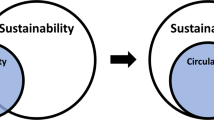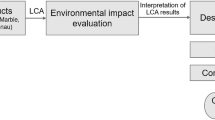Abstract
Traditional life-cycle assessment begins with a product and examines its environmental impacts throughout its life cycle. An alternative approach is to proceed in reverse: to examine the need that the product is designed to fulfill, to determine the minimal environmental impacts that could be engendered by filling that need, and thereby to design the “ideal green product” for the purpose. This approach, termed reverse life-cycle assessment (RLCA), is demonstrated by examining the environmental impacts attributable to a generic washing machine of current design, and then by reviewing other ways in which the provisioning of clean clothing may be accomplished. RLCA, as used here, is shown to encourage systems thinking and to identify opportunities for innovation in design and in marketing of environmentally-responsible products in ways that would be unlikely to arise from a traditional LCA.
Similar content being viewed by others
References
Curran, M.A.: Broad-Based Environmental life Cycle Assessment, Environmental Science and Technology 27, 430–436 (1993)
Weitz, K.A.;Malkin, M.;Baskir, J.N.: Streamlining Life-Cycle Assessment: Conference and Workshop Summary Report, Research Triangle Park, NC: Research Triangle Institute (1995)
Owens, J.W.: Discussion Paper on the Feasibility of Develo** Characterization Models for Various Impact Categories, ISO/TC 207/SC 5/WG 4/N 30, International Standards Organization, Stockholm (1995)
Wheeler, D.: What Future for Product Lifecycle Assessment? Integrated Environmental Management 20, 15–19 (1993)
Dixcee,A.: Washing machine design: The environmental dimension, Industry and Environment, Oct.-Dec. 1993, pp. 43-45, Nairobi: United Nations Environment Programme
Graedel, T.E.;Allenby, B.R.;Comrie, P.R.: Matrix Approaches to Abridged Life-Cycle Assessment, Environmental Science and Technology 29, 134A-139A (1995)
Graedel, T.E.;Allenby, B.R: Industrial Ecology, Englewood Cliffs, N.J.: Prentice-Hall (1995)
Graedel, T.E.: Weighting Functions in Streamlined Life-Cycle Assessment, Intl. J. Life Cycle Assessment 1, 85–89 (1996)
ISO/DIS 11469, Generic Identification and Marking of Plastic Parts; ISO 1043, Plastics — Symbols, Parts 1–3; SAE J1344, Marking of Plastic Parts
American Fiber Manufacturers Association, Resource and Environmental Profile Analysis of a Manufactured Apparel Product: Woman’s Knit Polyester Blouse, Washington, D.C. (1993)
Brown, L.R.;Flavin, C;Kane, H.: Vital Signs, 1996, New York: W.W. Norton (1996)
Author information
Authors and Affiliations
Rights and permissions
About this article
Cite this article
Graedel, T.E. Designing the ideal green product: Lca/SCLA in reverse. Int. J. LCA 2, 25–31 (1997). https://doi.org/10.1007/BF02978714
Issue Date:
DOI: https://doi.org/10.1007/BF02978714




